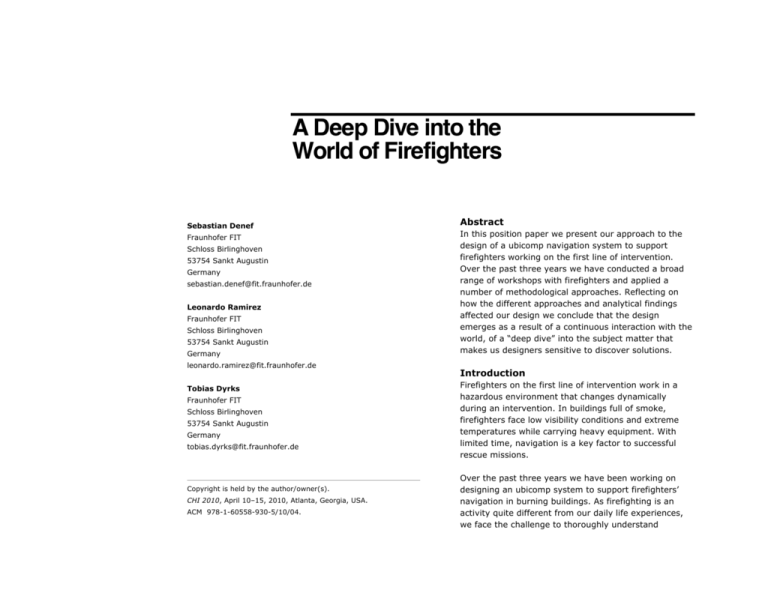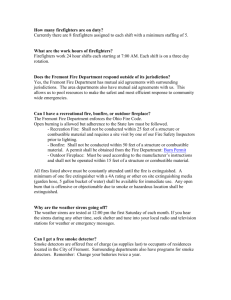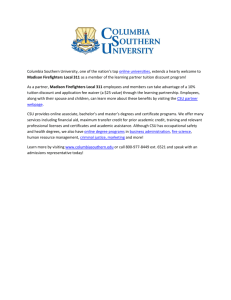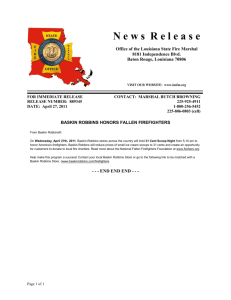Paper
advertisement

A Deep Dive into the World of Firefighters Sebastian Denef Fraunhofer FIT Schloss Birlinghoven 53754 Sankt Augustin Germany sebastian.denef@fit.fraunhofer.de Leonardo Ramirez Fraunhofer FIT Schloss Birlinghoven 53754 Sankt Augustin Germany leonardo.ramirez@fit.fraunhofer.de Tobias Dyrks Fraunhofer FIT Schloss Birlinghoven 53754 Sankt Augustin Germany tobias.dyrks@fit.fraunhofer.de Copyright is held by the author/owner(s). CHI 2010, April 10–15, 2010, Atlanta, Georgia, USA. ACM 978-1-60558-930-5/10/04. Abstract In this position paper we present our approach to the design of a ubicomp navigation system to support firefighters working on the first line of intervention. Over the past three years we have conducted a broad range of workshops with firefighters and applied a number of methodological approaches. Reflecting on how the different approaches and analytical findings affected our design we conclude that the design emerges as a result of a continuous interaction with the world, of a “deep dive” into the subject matter that makes us designers sensitive to discover solutions. Introduction Firefighters on the first line of intervention work in a hazardous environment that changes dynamically during an intervention. In buildings full of smoke, firefighters face low visibility conditions and extreme temperatures while carrying heavy equipment. With limited time, navigation is a key factor to successful rescue missions. Over the past three years we have been working on designing an ubicomp system to support firefighters’ navigation in burning buildings. As firefighting is an activity quite different from our daily life experiences, we face the challenge to thoroughly understand firefighting practice and to design a new tool that builds on existing rules and tactics. As of now, we have developed a working prototype of the system. It comprises a network of sensor beacons that firefighters use to tag relevant places in buildings and a body unit that allows firefighters to interact with the sensor network. The design process so far has been very promising as our project partners and especially the firefighters are excited about the system that they enthusiastically describe as a tool with the clear potential to provide valuable support to their dangerous work. Central to our approach is the exploration of the unknown design space [11], or, as design firm ideo calls it, a “deep dive” [1] into the manifold aspects of the subject matter with the goal to educate us designers. We therefore performed a wide range of workshops with firefighters. In the following, we will give a brief description of this work and reflect on the impact on our current design. Workshops In the beginning of our work, we collaborated with the firefighters of Paris, to challenge the technological vision that precise position information is key to indoor navigation. Therefore, we developed a wizard-of-oz system providing a firefighting commander a visualization of all the exact positions of each of his troops during a simulated mission in a firefighting training facility. We captured the experiment via video from many perspectives and analyzed critical incidents and breakdown situations [3]. To understand what firefighting feels like and thereby develop empathy [9] with firefighters, we personally took part in simulated interventions and fire trainings. Equipped with SCBA apparatus and protective clothing we had the chance to put hands on the equipment of firefighters, to crawl through a tunnel with smoke and fire, to experience the development of fire and to learn about the propagation of smoke. In our current project [6] with the firefighters of Cologne, Germany we could play an entire intervention in Europe’s most advanced firefighting training facility, do search and rescue missions [5] and join heat training exercises in a facility where we lifted heavy equipment facing high temperatures and serious fire. To study the effects of our new tools in firefighting practice and to gradually develop our concepts and system, we performed a number of experience prototype [2] design workshops in which new ideas where tested in simulated rescue mission. We began by using simple means to simulate a network of beacons that firefighters could use to mark reference points in buildings. Iteratively, we worked on the concept, technical components, form factors and interaction design of the system components and again tested them in simulated interventions. In such workshops we also evaluated existing products based on similar concepts. These exercises were followed by participatory design workshop in which we decided the next steps with our project partners from industry, academia and the firefighters. Looking for new means of interaction, we designed a visual feedback mechanism in iterations that provides firefighters the possibility to see RSSI values of the sensor network directly in their breathing mask. In tests with firefighters we decided on the position of the visual feedback and looked for requirements posed by different light conditions. To explore input mechanisms, we handed out commercial jackets to the firefighters that allow the wearer to control an integrated MP3 player using interactive fabrics. With no further instructions given, firefighters could test them in their spare time. After some months, we conducted interviews to learn about how the firefighters used the jackets and how they liked them. We also asked them about their views on using such interaction technique in firefighting interventions. problem, they developed a concept of how to integrate the new technology into existing equipment. Alongside these technological experiments, we did further ethnographic investigations and studied the tools that firefighters currently use. We asked an entire brigade to empty their pockets and tell us about the things that they carry. While analyzing our recordings, we looked for qualities or patterns that they these tools share [4]. Not all our analytical results are manifest in the current design; still they can provide meaningful contributions to the process. Some of the studies, like the investigation of existing firefighting tools, served us to confirm that our design fits into its ecosystem. Findings also were used as high-level guidelines and helped us to decide what not to design in the first place. In Retrospective Conclusion When we reflect on our current artifacts to understand how we transferred our analytical findings into design, we clearly do see connections but often they are not linear or straightforward. In many cases only the connection of the designers’ own experience and findings in previous workshops helped to find a design solution to a given problem. For us, the relation between contextual analysis and design remains surprising. During investigations patterns emerge that serve us as landmarks in the unknown design space [11], we discuss design tensions [10] that we are confronted with. Such directions, however, do not necessarily provide the answers and ideas that we need, the interpretation of such guidelines remains challenging. Our “deep dive” [1] into the world of firefighting has given us numerous insights and provides the basis for our design. From this perspective, contextual analytical findings are the means for the designer to develop theoretical sensitivity [8], they help to form an intuition that allows discovering design solutions. The design of the form factor for our beacons, for instance, was the idea of two engineers after they took part in a simulated intervention. Earlier that day, a commander described the challenge of giving additional equipment to already heavily loaded firefighters. Now that the two engineers had hands-on experience of the In another case, a presentation of a sequential analysis of a simulated intervention with an existing device sparked a discussion for the need for directional RF antennas and resulted in an investigation of where to position such antenna on a firefighter. Mounting the antenna to the firefighter’s helmet thereafter suddenly improved the in-mask feedback mechanism, as the firefighter would now gain the opportunity to literally look for RF signals. 4 Acknowledgements This work is supported partially by the German Government as part of the landmarke project (contract no. 13N9916). We are especially grateful to the Firefighters of Cologne and all other project partners for their invaluable support in this research. References [1] ABC News, (1999) Nightline: The Deep Dive was broadcasted on 1999-02-09, it is also available on dvd/VHS, code: N990209 01, from http://www.abcnewsstore.com/ [2] Buchenau, M. and Suri, J. F. 2000. Experience prototyping. Abstracts of DIS '00. ACM, New York, NY, 424-433 [3] Denef, S., L. Ramirez, T. Dyrks, and G. Stevens, Handy navigation in ever-changings Spaces: an ethnographic study of firefighting practices. DIS 2008, NY: ACM Press. p. 184–192. [4] Denef, S., Ramirez, L., Dyrks, T. 2009. Letting Tools Talk: Interactive Technology for Firefighting. Extended Abstracts of CHI 2009. New York, NY: ACM Press. p. 4447–4452. [5] Dyrks, T., Ramirez, L., Denef, S., Penkert, B., Meyer, D. 2009. Designing for Firefighters—Building Empathy through Live Action Role-Playing. Abstract of ISCRAM 2009. [6] landmarke project. 2008; Available from: http://landmarke-projekt.de. [7] Ramirez, L., Denef, S., and Dyrks, T. 2009. Towards human-centered support for indoor navigation. In Proceedings of the 27th international Conference on Human Factors in Computing Systems (Boston, MA, USA, April 04 - 09, 2009). CHI '09. ACM, New York, NY, 1279-1282. [8] Strauss, Anselm; Corbin, Juliet M. 1990. Basics of qualitative research: Grounded theory procedures and techniques. Thousand Oaks, CA, US: Sage Publications, Inc. (1990). [9] Suri, J. F., Empathic Design: Informed and Inspired by other people's experience, in Empathic Design - User experience in product design, I. Koskinen, T. Mattelmäki, and K. Battarbee, Eds. 2003, IT Press: Finland. p. 51-57. [10] Tatar, D. 2007. The design tensions framework. Hum.-Comput. Interact. 22, 4 (Nov. 2007), 413-451. [11] Westerlund, B. Design space conceptual tool grasping the design process. in Proceedings of the Nordic Design Research Conference. 2005. Copenhagen, Denmark. About the Authors Sebastian Denef is an interaction designer who has been working at Fraunhofer FIT for the last 3 years. Prior to FIT, he has been working in a design firm designing mobile services. Leonardo Ramirez is a researcher at Fraunhofer FIT. He holds a M.Sc. degree in software engineering from the Universidad Católica de Chile. Tobias Dyrks manages the landmarke project at Fraunhofer FIT. He holds a degree in Business Informatics.





